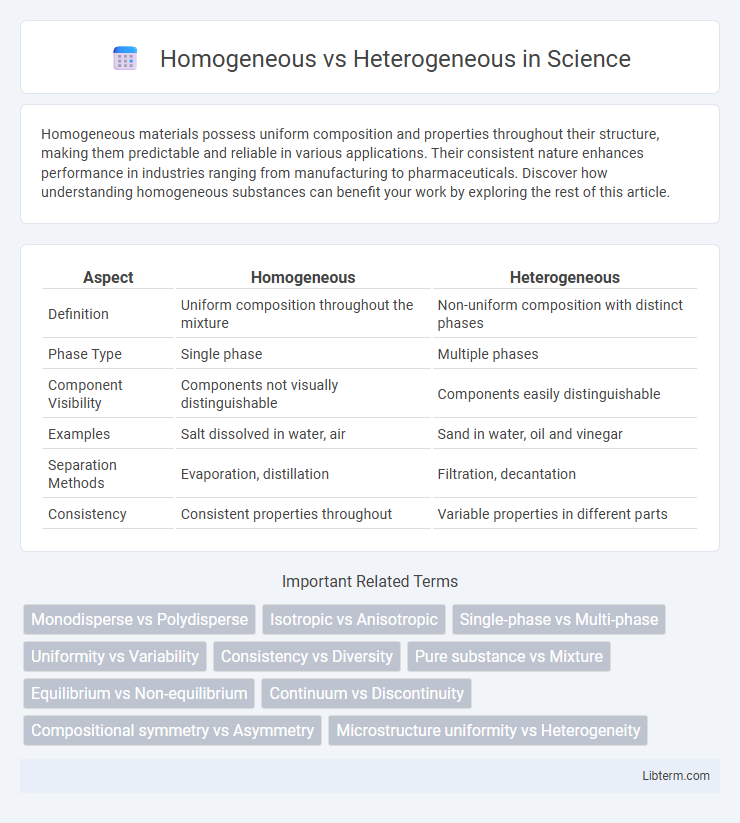Homogeneous materials possess uniform composition and properties throughout their structure, making them predictable and reliable in various applications. Their consistent nature enhances performance in industries ranging from manufacturing to pharmaceuticals. Discover how understanding homogeneous substances can benefit your work by exploring the rest of this article.
Table of Comparison
| Aspect | Homogeneous | Heterogeneous |
|---|---|---|
| Definition | Uniform composition throughout the mixture | Non-uniform composition with distinct phases |
| Phase Type | Single phase | Multiple phases |
| Component Visibility | Components not visually distinguishable | Components easily distinguishable |
| Examples | Salt dissolved in water, air | Sand in water, oil and vinegar |
| Separation Methods | Evaporation, distillation | Filtration, decantation |
| Consistency | Consistent properties throughout | Variable properties in different parts |
Introduction to Homogeneous and Heterogeneous
Homogeneous systems consist of components that are uniform in composition or nature, often resulting in consistent behavior and predictable interactions. Heterogeneous systems, in contrast, are composed of diverse elements with varying properties, leading to complex interactions and varied performance outcomes. This distinction is fundamental in fields such as chemistry, materials science, and computing, impacting system design and functionality.
Defining Homogeneous Characteristics
Homogeneous characteristics refer to uniform properties or features that are consistent throughout a substance or group, ensuring predictability and similarity in behavior or composition. These traits facilitate standardization, such as in materials science where homogeneous mixtures have identical molecules distributed evenly. In data analysis, homogeneous data sets exhibit similar attributes, improving the accuracy of modeling and segmentation processes.
Defining Heterogeneous Characteristics
Heterogeneous systems consist of diverse components or elements with different characteristics, such as varying data types, processing speeds, or architectures. These systems enable interoperability and flexibility by integrating multiple platforms, devices, or operating systems to perform complex tasks efficiently. The defining characteristic of heterogeneity lies in the coexistence of dissimilar units, which often necessitates specialized protocols and middleware for seamless communication and data exchange.
Key Differences Between Homogeneous and Heterogeneous
Homogeneous systems consist of uniform components or elements that share similar properties, ensuring consistency and predictability in performance. Heterogeneous systems contain diverse components or elements with varying characteristics, enabling flexibility and adaptability but increasing complexity. Key differences include uniformity versus diversity, simplicity versus complexity, and consistent behavior versus variable interactions.
Real-World Examples of Homogeneous Materials
Homogeneous materials exhibit uniform composition and properties throughout, making substances like pure gold, distilled water, and air ideal real-world examples. These materials maintain consistency in physical and chemical characteristics regardless of the sample size or location within the material. Applications in industries such as electronics, pharmaceuticals, and food processing rely heavily on the predictable behavior of homogeneous materials.
Real-World Examples of Heterogeneous Materials
Heterogeneous materials consist of visibly distinct phases or components, such as concrete, which combines cement, sand, gravel, and water to form a composite with varying properties throughout. Soil is another example, containing different layers of minerals, organic matter, air, and water, resulting in non-uniform physical and chemical characteristics. Wood shows heterogeneity with its grain patterns, knots, and varying density, all influencing its mechanical strength and appearance.
Advantages of Homogeneous Systems
Homogeneous systems offer advantages such as simplified management and maintenance due to uniform hardware and software configurations, which reduce compatibility issues and streamline updates. They enhance system reliability and performance by minimizing variability, facilitating easier troubleshooting and consistent behavior across the network. Cost efficiency is improved through bulk purchasing and standardized training for IT staff, leading to reduced operational expenses.
Advantages of Heterogeneous Systems
Heterogeneous systems offer enhanced computational efficiency by leveraging diverse hardware components such as CPUs, GPUs, and FPGAs, enabling optimized performance for specialized tasks. They provide flexibility in workload distribution, allowing complex applications to run more effectively through parallel processing and resource-specific advantages. Moreover, heterogeneous architectures improve energy efficiency by assigning tasks to the most suitable processing units, reducing overall power consumption compared to homogeneous systems.
Applications in Industry and Science
Homogeneous systems, characterized by uniform composition, are extensively used in chemical manufacturing processes like pharmaceuticals, where consistent reactions are crucial. Heterogeneous systems, comprising distinct phases, are vital in catalysis and environmental engineering, enabling efficient separation and reaction control. Industrial applications leverage homogeneous systems for uniform product quality, while heterogeneous systems enhance processes such as material synthesis, wastewater treatment, and energy storage in scientific research.
Choosing Between Homogeneous and Heterogeneous
Choosing between homogeneous and heterogeneous systems depends on the specific application requirements, such as compatibility, performance, and scalability. Homogeneous systems offer uniformity and simplified management, making them ideal for environments requiring consistency and ease of maintenance. Heterogeneous systems provide flexibility and optimized resource utilization by integrating diverse components, suitable for complex workflows demanding specialized processing capabilities.
Homogeneous Infographic

 libterm.com
libterm.com